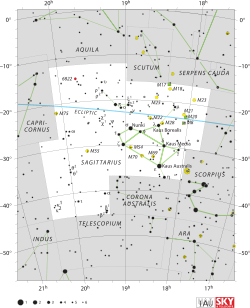Delta Sagittarii

Location of δ Sagittarii (circled) | |
| Observation data Epoch J2000.0 Equinox J2000.0 | |
|---|---|
| Constellation | Sagittarius |
| Right ascension | 18h 20m 59.64354s[1] |
| Declination | −29° 49′ 41.1659″[1] |
| Apparent magnitude (V) | +2.70[2] |
| Characteristics | |
| Spectral type | K3 III[3] |
| U−B color index | +1.55[2] |
| B−V color index | +1.38[2] |
| Astrometry | |
| Radial velocity (Rv) | –19.9[4] km/s |
| Proper motion (μ) | RA: +32.54[1] mas/yr Dec.: −25.57[1] mas/yr |
| Parallax (π) | 9.38 ± 0.18[1] mas |
| Distance | 348 ± 7 ly (107 ± 2 pc) |
| Absolute magnitude (MV) | −1.99[5] |
| Details | |
| Mass | 3.35 ± 0.34[6] M☉ |
| Radius | 129[6] R☉ |
| Luminosity | 2,500[6] L☉ |
| Surface gravity (log g) | 0.74 ± 0.10[6] cgs |
| Temperature | 3,600 ± 300[6] K |
| Other designations | |
Delta Sagittarii (Delta Sgr, δ Sagittarii, δ Sgr) is a double star[7] in the southern zodiac constellation of Sagittarius. It has the traditional names Kaus Media, Kaus Meridionalis, and Media.The apparent visual magnitude of this star is +2.70,[2] making it easily visible to the naked eye. Parallax measurements place the distance at roughly 348 light-years (107 parsecs) from Earth.[1]
This is a giant star with a stellar classification K3 III. It has a mass of about 3.4 times that of the Sun, while the outer envelope has expanded to 129 times the Sun's radius. With an effective temperature of roughly 3,600 K, it is radiating 2,500 times the luminosity of the Sun.[6]
It has three dim companions:[citation needed]
- a 14th magnitude star at a separation of 26 arcseconds,
- a 15th magnitude star at a separation of 40 arcseconds, and
- a 13th magnitude star at a separation of 58 arcseconds from the primary.
It is not certain that these stars form a physical system or whether they are merely aligned by chance.
Name and etymology
- The names Kaus Media, Kaus Meridionalis, and Media, are come from the Arabic قوس qaws 'bow' and Latin media 'middle'.
- This star, together with :
- In Chinese, 箕 (Jī), meaning Winnowing Basket, refers to an asterism consisting of δ Sagittarii γ Sagittarii, ε Sagittarii and η Sagittarii. Consequently, δ Sagittarii itself is known as 箕宿二 (Jī Sù èr, English: the Second Star of Winnowing Basket.)[11]
- In the Hindu system of astrology, this star is also called "Purvashada Nakshatra".
See also
- Delta Sagittarii in fiction
References
- ↑ 1.0 1.1 1.2 1.3 1.4 1.5 van Leeuwen, F. (November 2007), "Validation of the new Hipparcos reduction", Astronomy and Astrophysics 474 (2): 653–664, arXiv:0708.1752, Bibcode:2007A&A...474..653V, doi:10.1051/0004-6361:20078357
- ↑ 2.0 2.1 2.2 2.3 Johnson, H. L. et al. (1966), "UBVRIJKL photometry of the bright stars", Communications of the Lunar and Planetary Laboratory 4 (99), Bibcode:1966CoLPL...4...99J
- ↑ Houk, Nancy (1979), Michigan catalogue of two-dimensional spectral types for the HD stars 3, Ann Arbor, Michigan: Dept. of Astronomy, University of Michigan, Bibcode:1982mcts.book.....H
- ↑ Evans, D. S. (June 20–24, 1966), "The Revision of the General Catalogue of Radial Velocities", in Batten, Alan Henry; Heard, John Frederick, Determination of Radial Velocities and their Applications, Proceedings from IAU Symposium no. 30, University of Toronto: International Astronomical Union, retrieved 2009-09-10
- ↑ Elgarøy, Øystein; Engvold, Oddbjørn; Lund, Niels (March 1999), "The Wilson-Bappu effect of the MgII K line - dependence on stellar temperature, activity and metallicity", Astronomy and Astrophysics 343: 222–228, Bibcode:1999A&A...343..222E
- ↑ 6.0 6.1 6.2 6.3 6.4 6.5 Schröder, K.-P.; Cuntz, M. (April 2007), "A critical test of empirical mass loss formulas applied to individual giants and supergiants", Astronomy and Astrophysics 465 (2): 593–601, arXiv:astro-ph/0702172, Bibcode:2007A&A...465..593S, doi:10.1051/0004-6361:20066633
- ↑ 7.0 7.1 "del Sgr -- Star in double system", SIMBAD (Centre de Données astronomiques de Strasbourg), retrieved 2012-01-11
- ↑ "Sagittarius". deepsky.astroinfo.org. Retrieved 30 August 2008.
- ↑ skywatchers
- ↑ 10.0 10.1 Allen, R. H. (1963). Star Names: Their Lore and Meaning (Reprint ed.). New York: Dover Publications Inc. p. 355. ISBN 0-486-21079-0. Retrieved 2012-09-04.
- ↑ (Chinese) AEEA (Activities of Exhibition and Education in Astronomy) 天文教育資訊網 2006 年 5 月 11 日
External links
| ||||||||||||||||||||||||||